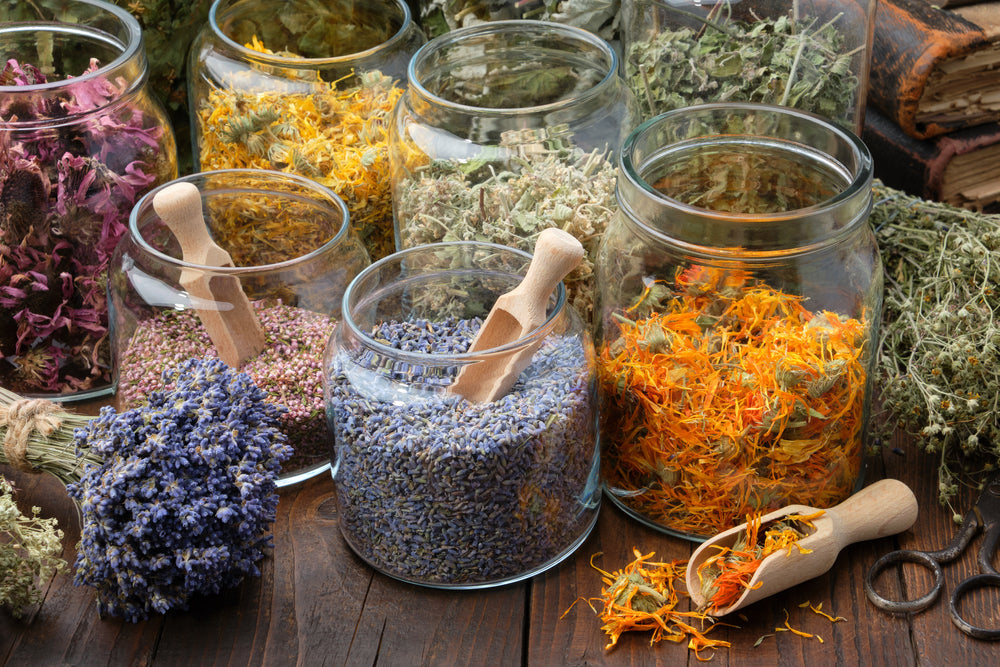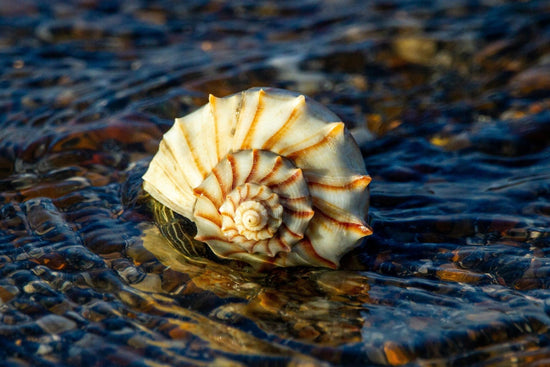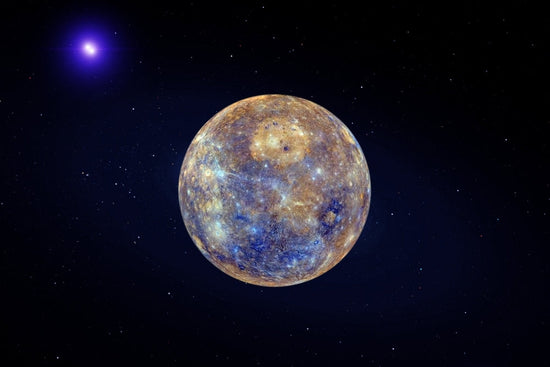Whether they’re used as natural remedies, burned during rituals, or selected as ingredients for a spell, plants have been associated with witches since time immemorial. And it’s no wonder: Plants are brimming with magical and medicinal properties that can be channeled into many different types of workings.
For some, a working relationship with plants can become a significant basis for magical practice. We’re talking about green witchcraft: a school of magic that draws on the power of nature. Most green witches are known for their botanical knowledge and ability to successfully incorporate herbs into spells, charms, rituals, and practical magic for everyday life.
With an overwhelming quantity of herbs to choose from and get to know, it can be intimidating to find the right place to start! That’s why we’ve created this guide to learning the properties and uses of some widely-used plants in green witchcraft.
The unrelenting vastness of the plant world makes it nearly impossible to catalog every single magical herb into a single article. For the purposes of this guide, we’ve narrowed it down to 17 of the most common plants green witches tend to use most often in practice. That being said, this list is far from complete! We’d love to hear your suggestions in the comments for how we can expand this resource in the future.
In this guide, each plant is cataloged with its Latin name as well as a few of its metaphysical correspondences, magical properties, and medicinal uses. As you come to understand the energy of each plant, you can use this information to select ingredients for your own spells or rituals based on the intention, focus, or goal of your working. You’ll also find a few links to goods in our online shop that contain pure essential oils derived from the featured plant.
* * *
Please note: Not all edible plants are safe to consume when pregnant or nursing. Please consult your doctor or herbalist to ensure your safety when using herbal remedies, supplements, or ingredients.
Additionally, we at Sea Witch Botanicals are not medical practitioners or certified herbalists. The medicinal information included in this reference guide is not intended to diagnose, treat, or cure any condition, nor should it substitute professional medical advice. Herbal medicine is not one-size-fits-all; every body is unique and has its own set of needs and sensitivities. If you have concerns for your health and/or are interested in integrating herbal remedies into your health plan, please consult a licensed doctor or herbalist to ensure you may do so safely and effectively.

The Magical and Medicinal Properties of Herbs
Apple, Malus pumila, Malus domestica, Pyrus malus, or genus Malus
The apple is the edible fruit of a domesticated tree in the rose family (Rosaceae). The plant is native to central Asia and is cultivated worldwide. Its seeds are poisonous in large amounts.
Correspondences: Water (element); Venus (planet); Autumn (season)
Magical uses: Love, fertility, healing, longevity, prosperity, protection, divination
Medicinal uses: Antioxidant; reduce risk of some cancers, asthma, and diabetes; slow the spread of cancer cells; lower cholesterol; protect against heart disease. (Source: NIH library)
Basil, Ocimum basilicum
Basil is an edible, aromatic herb with varieties widely used in Mediterranean and Southeast Asian cuisine. It is native to India and Southeast Asian countries such as Pakistan, Iran, and Thailand.
Correspondences: Fire (element); Mars (planet); Summer (season)
Magical uses: Prosperity, abundance, love, happiness, luck, protection, purification, banishment
Medicinal uses: Antioxidant and anticancer; lower blood sugar and cholesterol; manage blood pressure; improve neurocognition, boost mood, reduce stress and anxiety; boost immunity and heart health. (Source: Cleveland Clinic)
How we use it: Imbolc incense, with all-natural cedarwood, sandalwood, and lemon
Bay Laurel, Laurus nobilis
Bay laurel or bay leaf is a widely cultivated perennial shrub native to the Mediterranean, particularly coveted as a flavoring agent in cooking (though top chefs strongly favor fresh leaves over dried ones.)
Correspondences: Fire (element); Sun (planet); Spring (season)
Magical uses: Warding, protection, manifestation, purification, cleansing, luck, success
Medicinal uses: Antioxidant, anti-inflammatory, antifungal, antibacterial, antiviral, and anticonvulsant; pain relief; wound healing; immune boost; insect repellant. (Source: NIH library)
Chamomile, Matricaria chamomilla or Chamomilla recutita
Chamomile is an edible flowering plant native to Europe and commonly used for tea. There are two types of Chamomile (German and Roman). The two are closely related and share many magical and medicinal properties, yet German chamomile is more commonly used.
Correspondences: Water (element); Sun (planet); Summer (season)
Magical uses: Sleep, calm, meditation, love, prosperity, cleansing, purification, protection
Medicinal uses: Treat sleeplessness, anxiety, and gastrointestinal distress (stomachache, gas, diarrhea); used topically for skin conditions and mouth sores. (Source: NCCIH)
How we use it: Frith nourishing body soap; Roque grooming soap; Vasheen body soap & vulva wash; SuperNatural deodorant; Demeter lotion bar
Cinnamon, Cinnamomum verum
Cinnamon is a prized spice derived from the dried bark of cinnamon trees native to Southeast Asia. The leaves, flowers, fruits, and roots can be used as well. Ceylon cinnamon, known as “true cinnamon,” comes from the Cinnamomum verum tree; Cassia cinnamon (Cinnamomum aromaticum), on the other hand, is the type most commonly found in North American grocery stores.
Correspondences: Fire (element); Sun (planet); Winter (season)
Magical uses: Heat, passion, creativity, empowerment, sexuality, sensuality, romance, prosperity, protection, psychic powers, success
Medicinal uses: Supplement for diabetes, IBS, and other gastrointestinal issues; lowering blood sugar; oral hygiene; antioxidant, anti-inflammatory, antimicrobial, anticancer. (Sources: NCCIH, NIH library)
How we use it: Quoth the Raven collection; Yule incense; Ostara collection; Litha collection; Samhain incense; Krampus collection; Immunity Salve.
Dandelion, Taraxacum officinale
Dandelion is a flowering plant that grows fervently in grassy areas. While native to Eurasia, dandelions are not considered invasive as they do not “overwhelm healthy natural communities.” The entire plant is edible: The flowers can be used for wines or jellies; the leaves for salads or teas; the roots roasted as a substitute for coffee.
Correspondences: Air (element); Jupiter (planet); Spring (season)
Magical uses: Solar energy, joy, healing, transformation, growth, manifestation, divination, psychic powers
Medicinal uses: Antioxidant and anti-inflammatory; diuretic (helps lower blood pressure); control blood sugar; lower cholesterol; rich in vitamins A, C, and K; source of folate, calcium, and potassium. (Source: Cleveland Clinic)
Lavender, Lavendula officinalis or Lavendula angustifolia
Lavender is an edible flowering plant coveted for its sweet, relaxing aroma. It is native to the mountains of the Mediterranean and grows well in hot, dry climates.
Correspondences: Air (element); Mercury (planet); Summer (season)
Magical uses: Calm, sleep, peacefulness, happiness, longevity, protection, purification, cleansing, softness, love
Medicinal uses: Sleep support; pain relief (particularly menstrual pain); antimicrobial, antiviral, and anti-inflammatory; calm nervous system, lower blood pressure, manage anxiety and depression, and boost mood; reduce colic symptoms. (Source: Cleveland Clinic)
How we use it: Herbal Renewal collection; Hermitage collection; Timberwolf incense; Imbolc incense; Beltane incense; Woodland Salve; Mint-to-Be lip balm; Gibbous SuperNatural deodorant; Frith nourishing body soap; Veritum soothing facial toner
Lemon, Citrus limon
The lemon is the sour, edible fruit of a flowering evergreen tree in the Rutaceae family, native to Asia. Like many of our favorite citrus fruits, the lemon is not naturally occurring; it is a hybrid of sour orange and citron. It favors tropical and adjacent climates.
Correspondences: Water (element); Moon (planet); Spring (season)
Magical uses: Longevity, purification, love, friendship, brightness, inspiration, joy, vitality
Medicinal uses: Anti-inflammatory, antimicrobial, anticancer, antifungal, and antiparasitic; diabetes prevention and symptom management; some respiratory relief; bone health; cardiovascular health; skin health; liver health; boost mood. (Source: NIH library)
How we use it: Imbolc incense; Ostara collection.
Mint, genus Mentha
The mint family includes a wide variety of aromatic and culinary herbs, such as peppermint, spearmint, and more. Some varieties, such as pennyroyal, are not edible. The genus Mentha is native to Eurasia, North America, southern Africa, and Australia.
Correspondences: Air (element); Mercury (planet); Summer (season)
Magical uses: Cleansing, purifying, renewal, tranquility, vitality, love, prosperity, success, communication
Medicinal uses: Expectorant (relieve congestion and flush mucus), respiratory treatment, and common cold relief; antioxidant, antimicrobial, anti-yeast, and anticancer; some gastrointestinal relief; pain relief, particularly headache. (Source: NIH library)
How we use it: Timberwolf incense; Hummingbird incense; Beltane incense; Krampus collection; Immunity Salve; Mint-to-Be lip balm.
Mugwort, Artemisia vulgaris
Known as the mother of herbs, Mugwort is an edible flower plant in the daisy family that is native to Europe and eastern Asia. It can be consumed as a tea or culinary seasoning.
Correspondences: Earth (element); Venus (planet); Autumn (season)
Magical uses: Sleep, dreams, divination, psychic powers, inner wisdom, protection, banishment
Medicinal uses: Treat digestive problems; regulate menstruation; lower blood pressure; pain relief; liver health. (Sources: NCCIH and NIH library)
Patchouli, Pogostemon cablin
Patchouli is an edible flowering plant native to southeast Asia known for its strong, earthy aroma. The leaves can be used in herbal teas or used alongside other herbs to season food.
Correspondences: Earth (element); Saturn (planet); Autumn (season)
Magical uses: Prosperity, fertility, sexuality, grounding, attraction OR separation (depending on tradition), protection, peace, luck
Medicinal uses: Treat common cold, headache, fever, nausea vomiting, diarrhea, abdominal pain, and bites; boost mood, calm nerves, manage stress, and relieve depression; aphrodisiac. (Source: NIH library)
How we use it: Hermitage collection; Ostara collection; Samhain incense; Krampus collection; Fae Ring collection; Night Nymph collection; Crescent SuperNatural deodorant.
Rose, genus Rosa
The rose plant is a woody perennial renowned for the intoxicatingly sweet, fresh, floral scent its flowers produce. Most species are native to Asia, with several others at home in North America, Europe, or northwest Africa. All roses are edible, including the petals, buds, leaves, and hips.
Correspondences: Water (element); Venus (planet); Summer (season)
Magical uses: Self-love, romance, sensuality, passion, health, beauty, divination, protection
Medicinal uses: Anti-inflammatory, antimicrobial, and antidiabetic; anti-aging and skin repair; relieve menstrual cramps and treat dysmenorrhea; reduce stress, treat anxiety, relieve depression symptoms. (Source: NIH library)
How we use it: Lammas incense; Veritum soothing facial toner; Herb & Rose shampoo.
Rosemary, Salvia rosmarinus
Rosemary is an edible, evergreen flowering plant in the mint family (Lamiaceae) prized for its savory aromatics and used around the world as a culinary spice. It is native to the Mediterranean and extremely hardy, with some plants able to survive up to thirty years in a variety of climate conditions. Its Latin name, rosmarinus, literally means “dew of the sea.”
Correspondences: Fire (element); Sun (planet); Summer (season)
Magical uses: Solar energy, warding, protection, cleansing, purification, invigoration, healing
Medicinal uses: Antimicrobial, anti-inflammatory, antioxidant, antispasmodic, and anti-tumor; relieve headache and migraine; lift mood and depression; neuroprotective, heighten mental sharpness, strengthen memory. (Source: NIH library)
How we use it: Herbal Renewal collection; Timberwolf incense; Lammas incense; Samhain incense; Night Nymph collection; Woodland Salve; Crescent SuperNatural deodorant; Herb & Rose shampoo; Lucidum reishi facial serum.
Sage, Salvia officinalis
Native to the Mediterranean, sage, garden sage, or common sage is an edible flowering plant and classic culinary staple. Garden sage is not to be confused with sagebrush, or white sage (Salvia apiana), a plant native to the southwestern US and Mexico. White sage is sacred in closed Indigenous spiritual practices and overharvested by non-Indigenous folks primarily for the purpose of energy cleansing. Fortunately, plenty of other plants have powerful cleansing properties—including the common garden sage.
Correspondences: Air (element); Jupiter (planet); Autumn (season)
Magical uses: Cleansing, purification, emotional strength or healing, concentration and focus, mental clarity, grounding, divination, wisdom, guidance, wishes, luck
Medicinal uses: Antibacterial, antioxidant, anti-inflammatory, and antitumor; balance free radicals; improve memory; treat minor health problems. (Source: NIH library)
Thyme, Thymus vulgaris
Another of the mint family (Lamiaceae), thyme is an edible flowering plant and widely used culinary herb with a distinctive, sharp, herbaceous flavor. It is native to the Mediterranean and Eurasia.
Correspondences: Water (element); Venus (planet); Summer (season)
Magical uses: Health, longevity, sleep, psychic powers, love, purification, protection, prosperity, courage
Medicinal uses: Antioxidant, anti-inflammatory, and antimicrobial; support for cancer treatment; immune boost; stress relief; source of vitamins A, B6, C, K, and E; source of potassium, calcium, iron, manganese, magnesium, and selenium. (Source: NIH library)
How we use it: Ostara collection; Immunity Salve; Herb & Rose shampoo.
Witch Hazel, Hamamelis virginiana
Witch hazel is a flowering woody shrub or tree that has been used in traditional medicine for centuries, particularly by Indigenous peoples such as the Iroquois, Osage, and Potawatami. American witch hazel is native to the southeastern US, as denoted by its Latin name, virginiana, referring to its home in the state of Virginia.
Correspondences: Fire (element); Saturn (planet); Winter (season)
Magical uses: Emotional balance, healing heartache, hope, inspiration, wisdom, protection, purification, cleansing, divination, beauty
Medicinal uses: Anti-inflammatory and antiseptic; astringent (tighten pores, cleanse skin, and remove excess oil); hemostatic (prevent or stop bleeding). (Source: Chestnut School of Herbal Medicine)
How we use it: Veritum soothing facial toner; all scented veil spray perfumes.
Yarrow, Achillea millefolium
Yarrow is an ancient edible flowering plant native to California and found throughout North America and Eurasia. It can be used in gardens to attract pollinators and added to teas and foods for a bitter, peppery flavor.
Correspondences: Water (element); Venus (planet); Summer (season)
Magical uses: Warding, protection, purification, cleansing, divination, love
Medicinal uses: Hemostatic (prevent or stop bleeding); treat burns, sores, and open wounds; cure for fevers and colds; anti-inflammatory, antioxidant, and disinfectant. (Sources: US Forest Service, NIH library.)
* * *
Which herbs are you curious to learn more about? How do you like to use the herbs above? Let us know in the comments so that we can continue to expand this resource for budding witches and herbally-inclined folk far and wide.






3 comments
This has taught me a lot!! Thank you so much!!
I am in the process of making a special meditation herbal garden. It will be the shape of the pentagram. I have the plants chosen for the elements but I am having a hard time finding plants for the spirit. Does anyone have any ideas?
Herbal medicine has a rich history in Pakistan, with traditional remedies passed down through generations. Many people in Pakistan rely on natural herbs like turmeric, ginger, and neem to treat various ailments. These herbal solutions are often seen as safer alternatives to modern pharmaceuticals, with fewer side effects. However, it’s essential to ensure the quality and authenticity of herbal products. While herbal medicine can be effective, it’s important to consult a healthcare professional before using them, especially for serious conditions. Embracing both traditional wisdom and modern science can lead to a more balanced approach to health.
pakistan herbal medicine